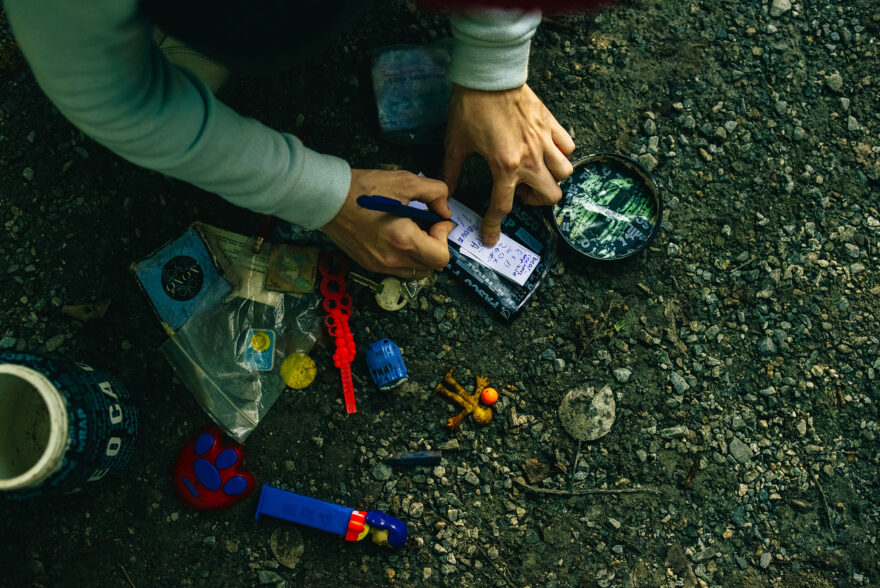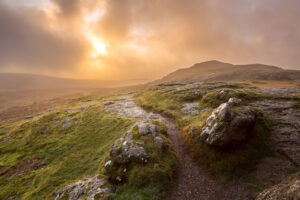
Image by Brester Irina, Shutterstock
Sometimes it’s easy to forget the simple joys of outdoor exploration — especially in the digital age where screen access is abundant. But tucked away in the corners of history are outdoor pastimes you can rediscover or learn about for the first time. Traditional outdoor activities like letterboxing, geocaching, and orienteering are making a comeback.
Letterboxing, which combines navigational skills and rubber stamp artistry, is a testament to human ingenuity and exploration. Geocaching, a modern-day treasure hunt guided by GPS coordinates, matches technology with discovery. And before satellites mapped every corner of the globe, orienteering stood as the ultimate test of navigation. Armed only with a map and compass, participants raced against time to locate checkpoints scattered across diverse terrains.
These forgotten outdoor traditions can offer you a path back to the simple joys of exploration and connection with nature. And for many people, these traditional activities are still alive today.
Letterboxing
Letterboxing traces its roots back to the 19th century on the moors of Dartmoor, England, where it was first introduced by James Perrott, a Victorian guide who created a system of markers to help travelers navigate the rugged terrain. Moors are wide-open spaces with hills, grass and a lot of fog filled with stories of historical adventurers.
In the 1850s, letterboxing truly took off. A group of Dartmoor hikers (known as the Cranmere Pool Letterboxers) took Perrott’s idea and developed it further. Their tradition of leaving behind letterboxes filled with a logbook and a rubber stamp inspired others to explore Dartmoor’s landscapes.

Image by ASC Photography, Shutterstock
Letterboxing is like an outdoor treasure hunt. But instead of searching for gold or jewels, you’re hunting for something called a “letterbox.” Letterboxing is a game where people hide small containers (called letterboxes) in parks, forests, or other outdoor places. Inside these letterboxes, there’s usually a stamp and a notebook. The goal is to find these hidden letterboxes using clues or hints provided by other letterboxers. When you find a letterbox, you use the stamp to mark your own notebook, and sometimes you can also leave your own stamp in the letterbox’s notebook.
It’s like a secret club where people explore nature, solve puzzles and share their adventures with others.
Many national parks have visitor centers or ranger stations where you can inquire about letterboxing activities and obtain clues or information about letterbox locations within the park. You can also use online resources to gather information about letterboxing. One of the most popular sites is Atlas Quest. On the Atlas Quest website you can search for letterboxes by location, browse through clues and hints provided by other letterboxers, log your finds and create your own letterboxing adventures.
Today, letterboxing continues to gain popularity in the United States. In the Great Smoky Mountains National Park hidden letterboxes await discovery. People, young and old follow clues, uncovering these hidden treasures and leave their mark in the logbook — creating lasting memories of their outdoor experience.
Orienteering
Before GPS, there was orienteering — a traditional navigation sport that challenges participants to find checkpoints outside using only a map and compass. Orienteers (as their called) race against the clock, navigating diverse terrains from forests to urban parks. It’s a test of both physical endurance and mental agility, requiring quick decision-making and precise map-reading skills.
Orienteering is sort of like a combination of adventure and navigation, and it’s been around for a while. It all started back in the late 19th century in Scandinavia, where soldiers used orienteering to train for moving through the wilderness. But it wasn’t until the early 20th century that it became a sport.

The person credited with inventing orienteering as a sport is a Swede named Ernst Killander. He came up with the idea of combining map reading and running through forests in a race-like setting. Since then, orienteering has grown into a popular activity enjoyed by people of all ages around the world.
Today, orienteering involves using a detailed map and a compass to navigate through forests, parks, or other outdoor areas, finding checkpoints along the way.
A popular place for orienteering in the United States is Harriman State Park, located in Rockland and Orange counties in New York. It’s one of the largest state parks in New York and offers a variety of terrains, including forests, lakes and valleys — making it an ideal location for orienteering events. The park hosts numerous orienteering competitions and attracts orienteers from all over the country due to its challenging courses and scenic surroundings.

Harriman State Park in New York (Image by quiggyt4, Shutterstock)
Here’s how you can get involved and complete an orienteering activity:
Find an Event: Look for orienteering events happening in your area. You can often find these through local orienteering clubs or online event calendars.
Register: Sign up for the event and pay any necessary fees. Some events might require pre-registration, while others allow you to register on the day of the event.
Get Your Gear: Before the event, make sure you have the right gear. You’ll need a good pair of running shoes, comfortable clothes for outdoor activity, a map and a compass. Some events might provide maps, but it’s a good idea to bring your own compass just in case.
Attend the Event: On the day of the event, arrive at the designated start location at the specified time. You’ll likely receive your map and any instructions or guidelines from the event organizers.
Study the Map: Take some time to study the map before you start. Look for landmarks, trails and the location of the checkpoints (often called “controls”) you need to find.
Plan Your Route: Decide on the best route to take to reach each checkpoint in the shortest amount of time. Consider the terrain, your fitness level and any obstacles you might encounter along the way.

Start Orienteering: When you’re ready, start navigating your way through the course, using your map and compass to guide you to each checkpoint. Move at your own pace, running or walking as needed.
Find the Checkpoints: As you reach each checkpoint, use your map and compass to locate the next one. Check off each checkpoint as you find it.
Finish the Course: Once you’ve found all the checkpoints, make your way to the finish line. Congratulations, you’ve completed the orienteering course.
Reflect and Enjoy: Take some time to reflect on your orienteering experience and enjoy the sense of accomplishment from navigating through the course successfully. Orienteering is not just about speed; it’s also about strategy, navigation skills and enjoying the outdoors.
Geocaching
Geocaching is like a modern-day treasure hunt. This activity doesn’t have the extended history like others on this list, but is a more recent creation, starting with Dave Ulmer in May 2000. Ulmer wanted to test the accuracy of GPS systems, so he hid a container with some stuff inside in the woods near Portland, Oregon. He posted the coordinates online and challenged people to find it using their GPS devices.
The idea caught on quickly. Soon people all over the world were hiding their own containers — called caches — and sharing the coordinates online for others to find. These caches come in all shapes and sizes, from tiny film canisters to large ammo boxes. Each cache holds a logbook for finders to sign and sometimes trinkets for trading.

Geocaching became a fun hobby for adventurers of all ages, and now more than two decades later, there are millions of caches hidden in all sorts of places around the globe, waiting to be discovered by people armed with GPS devices and a sense of adventure.
Geocaching is popular in around the U.S., but one of the hot spots is Yellowstone National Park, located primarily in Wyoming but also extending into Montana and Idaho. Here’s an example of detailed instructions on how you could geocache in Yellowstone:
Geocache Title: Old Faithful Geyser View Cache
Research and Preparation: Before heading out, research the geocaches available in Yellowstone National Park using a geocaching app or website. Look for caches that interest you and match your hiking abilities. Check the park regulations regarding geocaching to ensure you follow all rules and guidelines.
Choose Your Cache: Select the “Old Faithful Geyser View Cache” from the available geocaches in Yellowstone. This cache is located near the iconic Old Faithful Geyser, offering a spectacular view of one of Yellowstone’s most famous attractions.
Gather Your Gear: Bring essential hiking gear, including water, snacks, a GPS device or smartphone with GPS capabilities, a pen or pencil for signing the logbook, and any other supplies you may need for a day hike in Yellowstone.
Navigate to the Coordinates: Use your GPS device or smartphone to navigate to the coordinates provided for the Old Faithful Geyser View Cache. Follow the designated trails and stay on marked paths to minimize environmental impact and respect park regulations.
Search for the Cache: Once you reach the coordinates, start searching for the hidden cache. Geocaches can be hidden in various places, such as under rocks, inside hollow trees, or concealed within natural features. Use clues provided by the cache description and hints from other geocachers to aid your search.

This isn’t the Old Faithful Geyser View Cache, but this is an example of how caches may be hidden. (Image by Photomann7, Shutterstock)
Sign the Logbook: When you find the cache, open it carefully and sign the logbook with your geocaching username and the date of your find. Some caches may contain small trinkets or trackable items. If you take an item, be sure to leave something of equal or greater value in return.
Respect the Environment: After signing the logbook and trading items (if applicable), reseal the cache and return it to its hiding spot exactly as you found it. Leave no trace of your visit and respect the natural surroundings and wildlife of Yellowstone National Park.
Log Your Find: Once you return home, log your find on the geocaching app or website, sharing your experience and any memorable moments from your adventure in Yellowstone.
Remember to always follow Leave No Trace principles and abide by park regulations when geocaching in Yellowstone National Park or any other natural area. Enjoy the adventure and the beauty of one of America’s most iconic national parks!
Suzanne Downing is an outdoor writer and photographer in Montana with an environmental science journalism background. Her work can be found in Outdoors Unlimited, Bugle Magazine, Missoulian, Byline Magazine, Communique, MTPR online, UM Native News, National Wildlife Federation campaigns and more.
 Your Privacy Choices
Your Privacy Choices